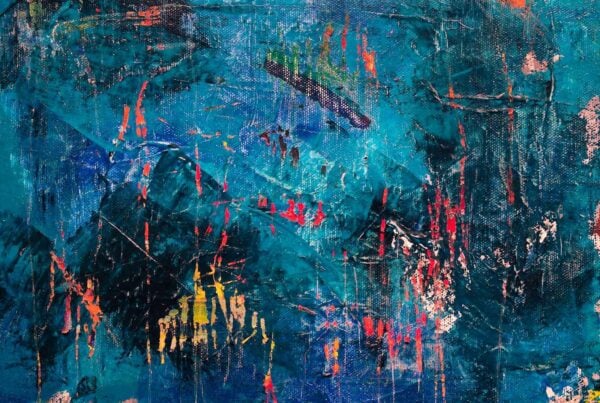Form in art means more than just shapes on a canvas—it is about three-dimensional objects that have height, width, and depth. Unlike a flat shape, form makes art look real, solid, and touchable. This is a key element of art, and we see it in everything from sculptures to realistic drawings.
Artists use form to make their work stand out, create the illusion of space, and express ideas in different ways. Whether working with geometric forms like cubes and spheres or more flowing organic forms, understanding form changes how we see and create art. For a more detailed explanation, visit this helpful guide about form in art.
Table of Contents
Key Takeaways
- Form gives artwork a three-dimensional quality.
- Artists use form to create depth and interest.
- Understanding form helps us create and enjoy different types of art.
Defining Form in Art
Form is a key visual element that helps artists create the illusion of three dimensions in a work. By understanding form, we can better see how artists make objects appear solid and real.
Form as an Element of Art
Form is one of the main elements of art, along with line, shape, colour, texture, value, and space. In art, form refers to objects that have three dimensions: height, width, and depth.
Unlike flat shapes, forms can be viewed from different angles. Artists use form to make objects look realistic or three-dimensional, whether they are working in painting, sculpture, or drawing.
We find form represented in both artwork and in real life. Things like cubes, spheres, cylinders, and cones are all examples of forms. Artists can combine different forms together to build complex scenes or subjects.
In paintings and other two-dimensional art, artists use shading, perspective, and highlights to create the appearance of form. These tools help make flat images appear lifelike and solid.
Difference Between Shape and Form
Shape and form are closely related, but they are not the same in art. A shape is a flat, two-dimensional area, while form is three-dimensional and has depth.
For example, a circle is a shape, but when we give it depth, it becomes a sphere, which is a form. In the same way, a square becomes a cube, and a triangle can become a pyramid.
The main difference is that shapes only have height and width, while forms have height, width, and depth. Artists use both shapes and forms to structure their compositions and create visual interest. While shapes are the building blocks, forms are what give artwork weight and mass. More information can be found here with clear comparisons and examples.
Characteristics of Form
Forms can be geometric or organic. Geometric forms are regular and follow mathematical rules, like cubes, cylinders, and spheres. Organic forms are more irregular, often found in nature, like stones, clouds, or trees.
Artists use light and shadow to show how form exists in space. They often draw or paint highlights where light hits the object and shadows where it is blocked. This technique helps the viewer understand the surface and structure of the form.
We see form everywhere in the real world and in different types of art, such as sculpture, which is always three-dimensional. In paintings, the use of form tricks our eyes into seeing depth and volume. By mastering form, artists can make their work look more realistic and engaging. A detailed explanation and the main types of form can be found here.
Types of Form: Geometric and Organic
Forms in art can be grouped into geometric forms or organic forms. Each has unique features that influence how we view and understand artwork. Simple shapes and complex forms also affect the visual impact of any piece.
Geometric Forms
Geometric forms are precise and regular. They include shapes like cubes, spheres, cylinders, pyramids, and prisms. These forms can be measured easily and are usually found in man-made objects. Buildings, machines, and most design products use geometric forms because they offer structure and order.
Artists often use geometric forms to create patterns, balance, and proportion in their work. The straight lines and smooth curves give a sense of stability and predictability. Geometric forms are often aligned with geometric shapes, such as squares and circles, providing a solid foundation for composition. For more about the qualities of these forms, see how geometric forms appear in art.
Organic Forms
Organic forms are found in nature. Unlike geometric forms, they are irregular and uneven. Their outlines may look free and flowing, like the curves of leaves, rocks, or the human body. Organic forms do not usually have straight lines or perfect edges.
We see organic shapes in trees, clouds, and living creatures. In art, using organic forms creates a sense of movement and life. These forms can make a piece feel more relaxed or natural. For more on the key qualities of organic forms and their natural look, they often appear unpredictable and lively, capturing the essence of living things.
Simple Shapes Versus Complex Forms
Simple shapes include basic geometric shapes such as circles, squares, and triangles. When we use these shapes to build forms, they remain easy to recognise and understand. Simple shapes can be grouped to create patterns, which help guide the eye and establish rhythm.
Complex forms come from combining or altering simple shapes. Adding more details or irregularity to a shape increases its complexity. Artists might combine both simple and complex forms to achieve balance and interest in their work. This mix can be seen in decorative objects, architectural details, and sculptures. Simple shapes make art accessible, while complex forms can challenge and intrigue us.
Form and Spatial Representation
Form in art helps us understand objects in space by showing how they take up room, suggest depth, and interact with their surroundings. We can see the use of three-dimensional shape, the illusion of form and depth, and techniques such as negative space, perspective, and proportion in works of art.
Three-Dimensional Form and Depth
Three-dimensional form refers to objects that have height, width, and depth. In sculpture and ceramics, we work with real three-dimensional shapes, such as spheres, cubes, and cylinders. These forms cast shadows and occupy physical space, which gives them a sense of volume and mass.
Artists focus on how light hits these surfaces, creating highlights and shadows that define the object’s structure. This helps us perceive the depth and solidity of the object. In painting and drawing, we create a sense of three-dimensionality by carefully showing light and dark areas, even if the surface is flat.
Looking at a three-dimensional form in art is different from looking at a two-dimensional shape because form feels real and affects how we read space in the artwork.
Illusion of Form in Two Dimensions
In two-dimensional art, such as drawings and paintings, artists cannot use actual depth. Instead, they create the illusion of form by using value, shading, and contour lines. These methods help flat shapes look solid, as if they could be held or touched.
A common technique is shading, where darker areas show where light is blocked, and lighter areas highlight where the light falls. We also use overlapping, changes in size, and placement on the canvas to reinforce the illusion of depth. This makes two-dimensional art appear more three-dimensional and convincing.
Perspective drawing enhances the illusion of space, making objects recede into the background or pop forward, depending on how we draw them.
Negative Space and Composition
Negative space is the empty area around and between the subjects in a work of art. We often overlook this, but it is vital for achieving balance and clarity in a composition. Artists use negative space to help define the edges of forms and organise the layout of the artwork.
By paying attention to the shapes created by negative space, we can create dynamic and interesting compositions. This technique can make certain areas stand out or recede, affecting how we interpret the space and depth within the image.
Here is how negative space helps with composition:
- Highlights the main forms
- Gives the artwork breathing room
- Creates strong visual interest
Careful use of negative space can also help suggest three-dimensionality and enhance the overall look of the piece.
Perspective and Proportion
Perspective is a method that artists use to represent three-dimensional spaces on a flat surface. It involves creating the illusion that some objects are nearer or farther away. Linear perspective, for example, uses lines that appear to meet at a vanishing point on the horizon to show depth.
Proportion is about the size relationships between different elements in an artwork. When the proportions are correct, forms look natural and believable. If the proportions are off, the objects may appear distorted or out of place.
Perspective and proportion work together to create a convincing sense of space. They help us arrange objects so that they appear balanced and connected, which makes the composition more effective and realistic. For more on how artists use form and perspective, we can look to classic examples in drawing and painting, where careful planning produces believable scenes.
Techniques to Create Form in Art
Creating form in art makes objects look three-dimensional and more lifelike. We use several key techniques such as value, line, light, and texture to give our work a strong sense of depth or volume.
Value, Tone, and Highlight
Value and tone are crucial for showing form because they help us represent light and dark. By carefully shading our drawings, we can suggest how light hits an object and where shadows fall. Lighter areas tell us where the light source is strongest, while darker tones show parts in shadow.
Highlights are the brightest spots on an object. When we add highlights, our drawings look more realistic. We can use tools like white pencils or an eraser to lift out highlights for extra contrast.
Artists practise using different grades of pencil, from very hard (H) to very soft (B), to get a full range of values. This makes our objects appear rounded instead of flat.
A quick example is drawing a sphere. By shading from dark to light and adding a small, sharp highlight, the circle turns into a solid 3D ball. Value and tone bring our images to life and make them believable.
Use of Line and Drawing
Lines can build the shape of an object and suggest its edges or details. In pencil drawing, changing the thickness or darkness of a line helps guide the viewer’s eye and create a sense of depth.
We use contour lines to show the outline of a form and cross-contour lines inside the shape to hint at the curves and surface. Cross-hatching and stippling are common marks used to suggest shadows and texture.
Line placement matters in design too, as stronger, darker lines may pull forward in space while lighter or broken lines may seem to recede. When combined with tone, lines can describe not only the shape but also how it sits in a space.
A well-placed set of lines can make a flat drawing appear more dimensional. The careful choice of line quality helps us create objects that have weight and form.
Chiaroscuro and Light
Chiaroscuro uses strong contrasts between light and dark to create dramatic volume and depth in art. Placing bright highlights next to deep shadows makes objects appear to come off the page.
Artists notice where direct light lands, where soft middle tones fall, and where cast shadows are sharpest. Light defines the main shapes, while shadow carves out the object’s form. Classic artists like Caravaggio and Rembrandt became famous for their use of chiaroscuro.
Using this high-contrast technique helps guide viewers to see shape, mass, and structure clearly. The interplay between highlight, shade, and shadow is essential for showing realistic form in art.
Texture and Intensity
Texture adds detail and lets us sense the surface of a subject, whether rough, smooth, soft, or hard. Artists create physical texture by layering materials, pressing with different pressure, or using special tools.
In pencil drawing, soft shading suggests smoothness, while rough, scratchy marks indicate bumpiness. Artists smudge, stipple, or hatch lines to show materials like cloth, stone, or metal.
Intensity means how strong or pure a colour or mark appears. Adjusting intensity can make forms pop forward or recede in a composition. Bright marks attract attention, while muted areas fall back.
Combining texture and intensity with value and line helps mimic real-world surfaces and brings artwork to life. Texture adds interest and supports the illusion of three-dimensional form. For further detail, see how depth is explained in form in art.
Form Across Artistic Mediums
Form appears in many art forms, providing a foundation for depth, structure, and meaning. We see it in painting through colour and shading, in sculpture as mass and volume, and in architecture as design.
Painting and Colour
In painting, artists use colour, light, and shadow to express form. Techniques like shading, highlights, and colour transitions suggest three-dimensionality on a flat surface, creating depth in landscapes, portraits, and still lifes.
Painters choose hues and contrast to make forms stand out or recede. Adjusting values and edges makes objects appear solid or soft. For example, warm colours help an object move forward, while cool tones make it recede.
A table of painting techniques for form:
| Technique | Effect on Form |
|---|---|
| Shading | Adds depth |
| Colour contrast | Defines edges |
| Highlights | Suggests texture |
| Blending | Softens transitions |
This use of colour and light gives forms weight and space, turning flat images into convincing representations. More about form in painting can be found at Understanding the Form in Art.
Sculpture and Three-Dimensional Space
In sculpture, form is tangible and occupies real space. Sculptors use stone, clay, wood, or metal to create objects with length, width, and height, giving sculptures volume, mass, and presence.
We can walk around sculptures and view them from every angle. Surface details like texture, smoothness, or pattern affect how light reflects and enhance depth. Negative space, or the empty areas around a sculpture, also defines the overall form.
Sculptors shape mass and volume to communicate ideas, emotions, or narratives. Realism, abstraction, and stylisation all help express artistic intent. As described at The Definition of “Form” in Art, understanding three-dimensional form helps us appreciate sculpture.
Mixed Media and Decorative Art
Mixed media combines different materials, adding new forms and textures to artwork. Artists might use paint, fabric, found objects, paper, or digital elements in one piece, creating a range of shapes and surfaces.
In decorative art, artists balance beauty with utility. Ceramics, jewellery, and textiles are designed to please the eye and serve a function. Patterns, symmetry, and unique materials distinguish decorative forms.
We notice contrasts between flat and raised areas, glossy and matte finishes, or soft and hard surfaces. These contrasts highlight features. Mixed media and decorative art show how artists shape form by combining diverse techniques and materials, resulting in visually rich and tactile art.
Architecture and Structural Form
Architecture uses form to unite function, stability, and beauty. Buildings are designed with attention to structure—how walls, roofs, and columns support weight and create spaces. Architects consider proportions, scale, and materials to make forms that are safe and attractive.
Features like arches, domes, and facades define a building’s style. The choice of glass, stone, concrete, or wood changes a building’s look and feel. Open spaces, light, and movement through structures result from careful planning of form.
Decorative details, such as mouldings or window patterns, add interest without changing a building’s structure. Architecture depends on the relationship between interior and exterior forms, seen in both traditional and modern designs. Learn more about form in architecture through Form in Art.
Form in Artistic Styles and Movements
Form takes different roles across art movements. Some styles focus on realistic shapes and detail, while others use simpler or distorted forms to express emotion or ideas.
Form in Realism and Representation
In realism, artists use form to create the illusion of real, three-dimensional objects. They carefully show how light, shade, and structure make up an object’s shape and volume. This attention to detail makes scenes and figures look lifelike.
Representational art shows the world as it appears. Artists study how forms sit in space and how surfaces reflect or absorb light. Techniques like shading, perspective, and contour drawing help make objects seem solid.
Through these methods, realists highlight fine differences in volume and surface. Their work invites viewers to feel as though they are looking at actual people, places, or things.
Abstract Art and Simplified Forms
Abstract art changes how we use form by moving away from lifelike representation. Artists simplify, distort, or exaggerate shapes to express mood, energy, or ideas. Forms become less about copying reality and more about showing what cannot be seen, such as feelings or concepts.
We see this in movements like Cubism, where artists break forms into flat shapes and arrange them in new ways. Some abstract artists use only basic forms like circles, lines, or blocks to fill the canvas.
This approach helps us focus on colour, structure, and movement within the artwork. The forms may not remind us of real objects, but they can still spark strong reactions and make us think about what the artist wanted to communicate. More about abstract and simplified forms can be found at the London Art Exchange.
Portraits and Expression
In portrait art, form does more than show what someone looks like. Artists use the shapes of faces, bodies, and shadows to reveal personality, mood, or social status. A tilt of the head or a strong chin can make a portrait feel lively or serious.
Expressionist painters often exaggerate forms in their portraits. They might stretch or twist shapes to show strong feelings, like sadness or joy. The way light falls across the face, or how eyes and mouths are drawn, can reveal emotion.
Through these choices, portraits become more than simple copies—they become powerful ways to share emotion and connect with viewers. For more about how form is used in sculpture and other media, see the National Gallery of Art.
Famous Artists and Examples of Form
Form in art can look very different depending on the artist and the style of the time. Some artists focus on realistic, three-dimensional figures, while others experiment with shapes, colours, and lines to offer new ideas about space and structure.
Leonardo da Vinci and Renaissance Form
Leonardo da Vinci is known for his detailed study of the human body and his skill in creating lifelike forms. He used light and shadow, a technique called chiaroscuro, to make his paintings look three-dimensional. In works like The Last Supper and Mona Lisa, he carefully models the faces and hands to appear realistic.
The Renaissance period valued accurate anatomy and perspective. Artists studied the skeleton, muscles, and proportions to create convincing forms. Leonardo took this further by dissecting bodies and sketching bones and organs.
His art is both beautiful and scientific. By making his figures look natural, he changed how artists thought about three-dimensional shapes in paintings and drawings. For more on this technique, see this explanation of form in art.
Wassily Kandinsky and Abstract Forms
Wassily Kandinsky pioneered abstract art. Instead of painting people or landscapes, he used shapes, lines, and colours to create new forms. In works like Composition VII, bold, swirling shapes fill the canvas without trying to look real.
Kandinsky believed these forms could express feelings and ideas without copying real objects. He thought a painting did not need to look like anything in the world to have meaning. His unique style inspired many artists to explore abstract forms.
His art features circles, triangles, and curved lines in expressive arrangements. Kandinsky’s approach changed the way we think about form, showing it can be imaginative and emotional. Find out more about abstract and representational form in art.
Piet Mondrian and Geometric Form
Piet Mondrian is famous for using simple geometric shapes and primary colours. In paintings like Composition with Red, Blue and Yellow, he divides the canvas into squares and rectangles with bold black lines.
Mondrian stripped away details to focus on the most basic forms. He wanted to create order and balance by limiting shapes and colours. This grid-like style is a key example of geometric form in art.
Mondrian’s influence appears in graphic design and modern architecture. His work shows how different shapes and lines can create harmony and structure. To see more examples and explanations of geometric form, visit this guide to form as an element of art.
Frequently Asked Questions
Understanding form in art means seeing how artists use shapes and structures to create or suggest three dimensions. Form helps us see depth, compare objects, and recognise the difference between flat and solid shapes.
What constitutes the concept of form within art?
Form in art is more than just shape. It refers to the visible, solid qualities of an object, including its volume, depth, and physical appearance. Form can describe something truly three-dimensional, such as a sculpture, or the way an artist creates the illusion of three dimensions on a flat surface.
Can you describe the two principal types of form in visual arts?
There are two main types of form: geometric and organic. Geometric forms have regular edges and clear shapes, such as cubes, spheres, or cylinders. Organic forms are more irregular and natural, like rocks, trees, or the human body. Artists use both types to create interest and realism. You can learn more about these types of forms at AccessArt.
How is the element of form utilised in art to create depth and dimension?
Artists use form in drawing, painting, and sculpture to give flat objects a sense of volume. By adding light and shadow, or changing the position and size of objects, they create the effect of three dimensions. This technique makes scenes and objects look more realistic and helps us feel the space within the artwork. The Tate offers further explanation on this.
In what ways does form differ from space in an artistic context?
Form and space are closely linked but not the same. Form is the actual object or shape shown, while space is the area around, between, or within forms. Artists use space to separate, connect, or highlight forms. Without space, we would find it hard to see where one form ends and another begins. Read more at the London Art Exchange.
What role does form play in art appreciation and analysis?
Form helps us talk about the physical presence of art, whether it’s a painting, sculpture, or building. When we look at art, we analyse form to understand how artists created or arranged objects. Form also lets us discuss how a piece feels—whether it looks solid, light, heavy, smooth, or rough.
How might one illustrate the concept of form to children learning about art?
We can help children understand form by showing them objects they can touch and see from different angles, such as blocks or balls. When children use clay or play-dough to build shapes, they see the difference between a flat drawing and a solid form. Talking about which objects feel “round” or “square” also builds their understanding. See more strategies at the National Gallery of Art.








